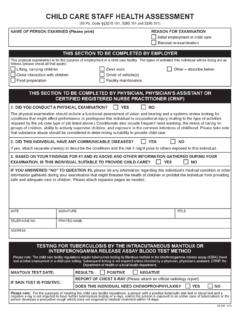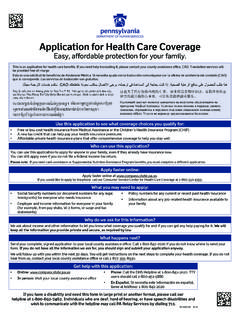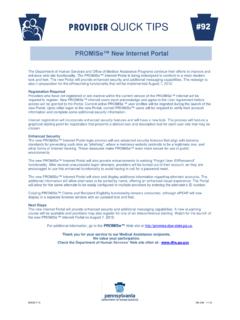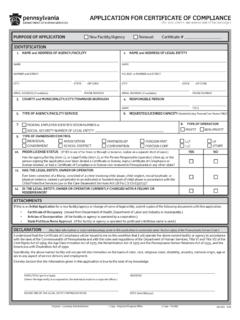Transcription of homeless assistance program - Pennsylvania Department of ...
1 homeless . assistance . program . INSTRUCTIONS AND. REQUIREMENTS. Revised April 2019. Tom Wolf, Teresa Miller, Governor Secretary Administered by: Office of Income Maintenance Bureau of Policy Lisa Watson, Deputy Secretary Cathy Buhrig, Director homeless assistance program Manager Ingrid Santiago, Human Services program Specialist TABLE OF CONTENTS. Changes from previous version ..4. I. OVERVIEW.. 5. A. Introduction..5. B. The homeless assistance program Goals .. 6. C. Continuum of Homelessness Services.. 7. II. HAP SERVICE COMPONENT DESCRIPTIONS .. 7. A. Case Management.. 7. B. Rental assistance .. 11. C. Bridge Housing .. 17. D. Innovative Supportive Housing Services .. 22. E. Emergency Shelter.. 23. III. HAP REQUIREMENTS .. 25. A.
2 Client Eligibility .. 26. B. County and Provider Responsibilities .. 28. C. Client Records ..30. D. Written Agreements ..31. IV. ALLOWABLE HAP EXPENDITURES GENERAL .. 32. V. FISCAL RESPONSIBILITIES .. 34. A. Cost Allocation Plan .. 34. B. Grant Revocation ..35. C. Payments .. 35. D. Automated Clearing House Process .. 35. E. Holding Funds .. 35. F. Unexpended Funds .. 35. G. Earned Interest .. 36. 2. H. Accrual Accounting .. 36. I. Audits .. 36. J. Maintaining Fiscal Records .. 36. K. County Human Service Planning and Expenditure Reports .. 37. L. Annual Client Data Report ..37. M. Revisions to County Plans.. 38. VI. RESOURCES AND INCOME .. 38. A. Income ..39. B. Resources .. 42. C. Affordability .. 43. VII. CLIENT APPEALS .. 44.
3 VIII. WAIVER REQUESTS .. 45. IX. program MONITORING .. 46. APPENDICES. A. EVALUATING program PROCESSES AND OUTCOMES. FOR CONTINUOUS QUALITY IMPROVEMENT ..50. B. SERVICE PLANS.. 53. C. FEDERAL POVERTY INCOME GUIDELINES.. 55. D. RENTAL assistance TRACKING FORM..57. E. COORDINATION WITH TITLE IV-A EMERGENCY SHELTER. assistance program .. 58. F. KEY DATES.. 60. G. CLIENT RECORDS ..61. H. ANNUAL CLIENT DATA REPORT.. 63. I. INCOME, RESOURCES AND AFFORDABILITY. CALCULATION WORKSHEETS..69. J. HAP Block Grant Counties ..74. 3. March 2019. CHANGES TO HAP I&R FROM THE PREVIOUS VERSION OF MAY 2018. Page 1 revised date updated. Page 55 Federal Poverty Income Guidelines changed to reflect new 2019 amounts. Page 59 Link to Cash assistance Handbook Emergency Shelter Allowance added.
4 Page 65 Description of Client Data Report line C. 7. was corrected. Page 67 Fiscal Year 2019-2020 Client Data Report added. Page 74 Armstrong and Indiana Counties added to list of HSBG counties. 4. I. OVERVIEW. A. INTRODUCTION. The homeless assistance program Instructions and Requirements (HAP I & R) manual provides operational guidance for the Pennsylvania Department of Human Services' (DHS) homeless assistance program (HAP). HAP is a county-directed program that offers a variety of supportive services to individuals and families experiencing or at risk for homelessness and who can demonstrate that, with HAP intervention, they will be able to meet their basic housing needs in the near future. HAP includes five components: 1. Bridge Housing 2.
5 Case Management 3. Rental assistance 4. Emergency Shelter 5. Innovative Supportive Housing A county may choose to provide one, some, or all of the components as part of its program , depending upon its unique regional needs. HAP gives counties flexibility in creating their programs because human service agencies based at the local level are intimately acquainted with the local human services network and the needs of the community. The Department expects that counties will select the components necessary to create a homeless assistance program that meets the following HAP objectives: 1. Provide homelessness prevention services that assist clients to maintain affordable housing. 2. Help people experiencing homelessness find refuge and care.
6 3. Assist people experiencing or near homelessness in attaining economic self- sufficiency. 5. The Commonwealth of Pennsylvania funds HAP through an annually state-funded block grant. The DHS Office of Income Maintenance (OIM) administers HAP and allocates a portion of the block grant funds to each county with the expectation that counties will design homeless assistance programs that meet HAP goals within the parameters outlined in the HAP I & R. Before 2001, all counties received HAP funds as a program -specific allocation. In 2012, Act 80 introduced county-based Human Services Block Grants (HSBG) in 20. Pennsylvania counties. The HSBG combined the funds of seven human services programs , including HAP, into one block grant. The HSBG reduced overall funding for the combined human services agencies; however, it gave counties the latitude to reallocate funds among the seven human services programs .
7 While the initial pilot included only 20 counties, in July 2013, Act 55 expanded the availability of HSBG funding to 30 counties. Act 153, enacted November 4, 2016, expanded the option for all counties to apply for participation in the HSBG program beginning July 1st, 2017. The Act also provides direction for counties that wish to withdraw from the HSBG program . The introduction of the HSBG presents HAP with exciting challenges. In each subsequent year following the implementation of the HSBG, HSBG counties can reallocate increasing percentages of the HSBG funds among the seven human services programs . While residents' needs will influence how counties allocate the HSBG funds, programs that demonstrate success through measurable outcomes will have greater credibility when justifying continued or increased funding.
8 The Department provides the HAP I & R as guidance for developing effective, locally integrated homeless assistance programs . The HAP I & R addresses HAP changes introduced with the HSBG and includes the HAP programs goals, descriptions of the five HAP components, criteria for client eligibility, allowable HAP expenditures, fiscal reporting requirements, and expectations for program monitoring. It also provides strategies for counties to identify program goals, measure outcomes, and use findings to refine and improve their programs (see Appendix A). B. THE homeless assistance program GOALS. Counties receiving HAP funding will develop programs that achieve the following goals: Mitigate the effects of homelessness on families and individuals through prevention activities, case management services, and housing and rental assistance .
9 6. Help families and individuals experiencing homelessness become self-sufficient and secure permanent living arrangements. Provide homelessness prevention activities, which allow the people who are near homeless to retain affordable housing or move to more affordable housing. Develop a continuum of services to support individuals and families who are experiencing or are at risk for homelessness. Comply with programmatic requirements ( verifying and calculating income, maintaining case notes, etc.), reporting requirements, and monitoring requirements as outlined in the HAP I & R. C. CONTINUUM OF HOMELESSNESS SERVICES. While HAP addresses housing issues specifically, in order to mitigate homelessness and help families achieve self-sufficiency, counties should view HAP as part of a larger holistic approach to human services requiring coordination between a variety of agencies and community services.
10 Counties should coordinate HAP planning with other agencies, enabling providers to link clients to other services necessary to achieve self-sufficiency. The community planning process should include staff from homeless service providers, state and local governments, human service providers, private foundations, local businesses and investors, the financial community, neighborhood groups, landlords and housing providers, and individuals and families who are or who have experienced homelessness. Planning and coordinating with other county service programs will help HAP. providers identify service needs, avoid duplicating services, and prevent disjointed service delivery. Counties can then leverage HAP funds to provide the most comprehensive, innovative, and cost-effective services to their residents who are homeless or at risk for homelessness.









